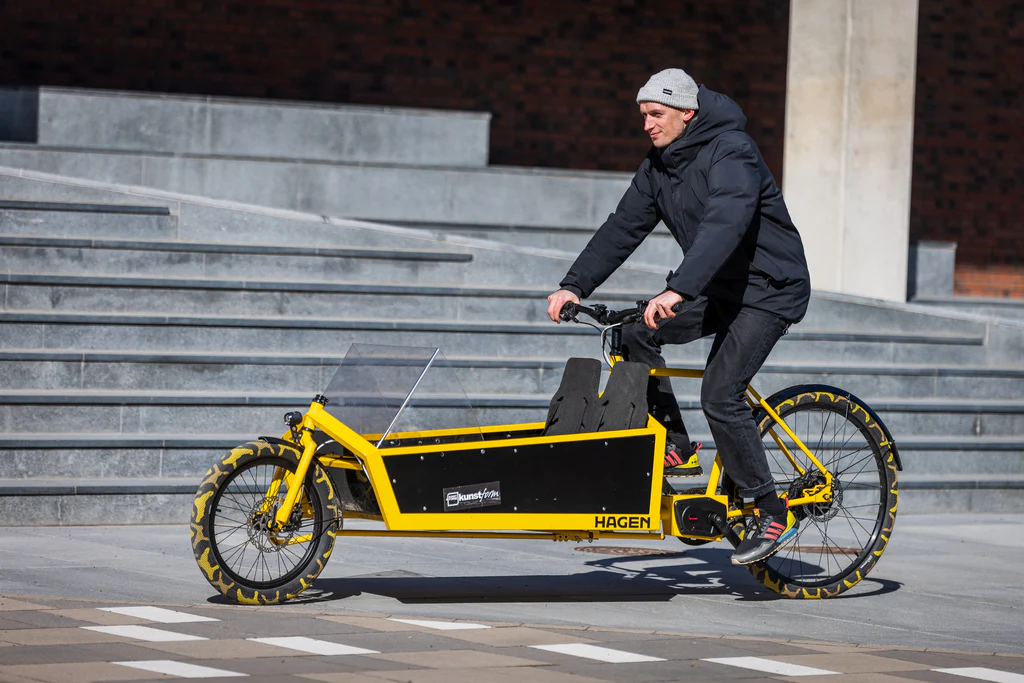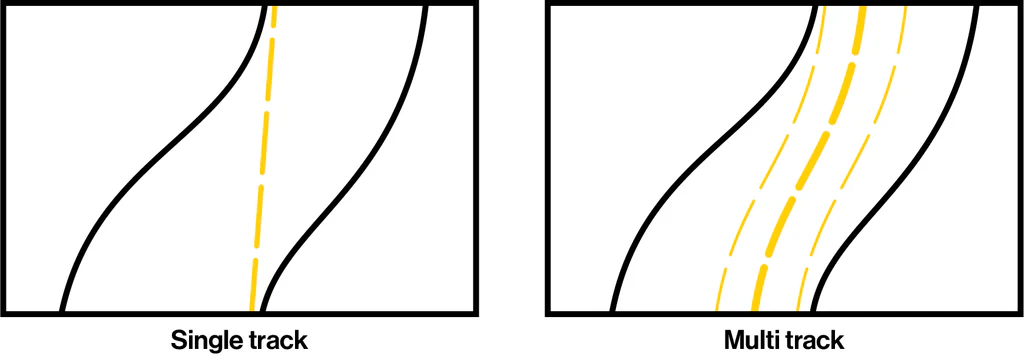
I have loved bikes throughout my life. From being a child and having the first freedom of getting around without parents, to doing sports, to having the freedom of being outdoors and traffic free on commutes. All bikes are beautiful – but they do come in various shapes and sizes. Talking to crowds that are new to cargo bikes, the biggest question seems to be – should I consider a 2-wheeler or a 3-wheeler. There are obvious differences, but you won’t really know their true effect before you try both in real life.
I have ridden a 2 wheeled cargo bikes for the last 4 years, but last week, I decided to rent a 3-wheeler, and see how it compares. Some of the differences I had in mind got confirmed, some were not true, and I discovered a few things I did not anticipate. So, let’s dive into it.
The bikes
2-wheeler: Hagen XL e-cargo, Brose S mag, 630Wh battery, Enviolo Automatiq gears, Belt drive
3-wheeler: Cangoo Easy, Shengyi rear wheel motor, 520Wh battery, Shimano Tourney TX6 gears, Chain drive

Single vs multitrack
The key difference between the two concepts for me is not the ability to lean in the corners or that one stands upright on its own. The key difference in everyday use for me was the difference between having a single track (all wheels are on the same line) of a 2-wheeler or multiple three tracks of the 3-wheeler.

The multitrack bike turned out to be much bumpier. It is simply very hard to avoid all bumps like sewage drains, potholes or others with all 3 wheels. The first day I was on the 3-wheeled bike, the snow started melting and that proved to be tricky for the multitrack bike. On car roads, the melted car track was not wide enough for all 3 wheels, and I was constantly sliding into the car track with my rear wheel, drifting all over the place.
Also, it was much harder to pass through small gaps or pass people. On a 2-wheeler, you can have about 40% of the bike’s width ‘hang over’ the side of the road. So, I had to use the bell a lot more to get pedestrians out of my way.
Where the multitrack bike shines, is the very low speed. Anything below 10 km/h can be tricky for less experienced riders on a single track bike, but the 3-wheeler is at its most stable in those speeds. That came in handy, especially during deep slush when the snow was melting. You never really needed to pay much attention to whether you have enough grip for the front tyre going into the corner.
Speed
I always expected the 2-wheeler to be faster, but with the eBike regulations keeping both bikes’ top speed at 25 km/h + 10% for tip-off, the straight-line speed is identical in theory. In daily use, however, the difference was clear. At speeds above 22 km/h, the 3-wheeler became unstable, and you really had to be on it the whole time not to start swaying around the road when hitting a small road imperfection with one of the wheels. I suspect that is not true for all 3-wheelers. There are probably some with better steering dampers than the Cangoo, so it’s something to look out for when shopping for one. It was however so smooth at 10-15 km/h that once I even ate a burger while riding – couldn’t do that with a 2-wheeler’s more sporty riding position.
I went as far as measuring the time it took for me to get from home to work to put the difference on paper. On a 2-wheeler, I did the 2.2 km distance in exactly 6 minutes when I rode normal. On a 3-wheeler, it took me 7 minutes 15 seconds. A surprisingly big difference that will be quite drastic on longer commutes.
Riding position
Most 2-wheelers have a sportier riding position, whilst 3-wheelers generally have a very upright position. There are pros and cons to both.
Sporty position is good for longer rides, and in my case also for my back. With the 3-wheeler, my back started hurting already the first day. The multitrack bike doesn’t even feel all that bumpy, the vibration is usually not intense, but it’s there, all the time as one of the 3 tracks will follow some imperfections of the road. This meant my small back injury from a few years back that had not bothered me for a year came back. The upright position of the 3-wheeler and its stability when trying to stand up on the pedals to go over larger bumps like low curbs etc is poor for absorbing the hits with your feet. So, everything hits you right through the saddle and into the back. From pretty much the first day, I was looking forward to returning the bike and regaining my back comfort, which returned right when I switched back to the 2-wheeler.

Pros and Cons
2-wheeler:
+ faster
+ more fun to ride
+ smoother ride
+ easier to manoeuvre
+ high speed stability
-Low speed stability
-Risk of tipping over in slippery conditions
-Less stability with heavy loads
3-wheeler:
+ low speed stability
+ can carry much heavier loads while remaining stable
+ stability in slipper conditions
+ you don’t have to put your foot down at traffic lights
+ No need to pull the bike on a kickstand when parking
+ Better visibility of the surroundings because of the upright position
-High speed stability
-Risk of tipping over in corners
-Much bumpier ride
Which should you choose?
There is a reason why both exist, and they both serve a purpose.
Choose a 3-wheeler if:
- Your single travel is up to 3 km
- You value low-speed stability, and you are okay to stay at 15-20 km/h speeds where the road is not perfect.
- You wish to carry over 100 kg regularly.
- You have issues with balance.
Choose a 2-wheeler if:
- You value speed and agility
- You ride around with 50-70 kg loads or less regularly.
- Your single travel is more than 3 km and/or daily travel over 15-20 km
Personal takeaways
The following will be from a standpoint of someone active, in good shape and who loves riding all sorts of bikes from road bikes to mountain bikes to BMX bikes, and someone who has been on a cargo bike for years.
I was surprised how much I disliked the non-tilting 3-wheeler. I had tried talking my wife into having a Christiania bike for 3–4 years now. When she saw this bike, she said, ‘this bike is ridiculous, it must be embarrassing riding this thing’. I had that feeling when I sat on the bike for the first time but ignored it as I thought I was the only one who would think so. Having her say it cemented the feeling. This bike was so uncool, combined with how it handles at full speed, how my back started hurting and the bulkiness – I couldn’t wait for the week to be over and return to my own bike. I started the test open-minded, and I ended disappointed at the bike and to be honest, a bit disappointed in myself too because I could not find many things to like about the bike. The only fun way of riding this bike was on two wheels, but after you learn how to turn both ways on 2 wheels, it gets boring too.
Our daughter luckily liked the bike, so I think for kids it won’t matter, they will enjoy riding any bike.
Based on this, my only advice on top of the above recommendations is that please, if you buy a cargo bike, and it’s the first one in the family, don’t buy one that neither of the parents will like riding one. Had I tried to find a bike that I thought my wife and I both would ride, I would have bought a 3-wheeler. Sadly, I would have hated it and I think my wife would have had too. Based on this test, I now know that she will be better off with a lighter 2-wheeler, and no longer will I try to talk her into buying a Christiania bike.
There are clear advantage for 3-wheelers, especially in places like Denmark and Holland where the bike lanes are wide and very smooth, thus making the disadvantages less profound. I will not be judging anyone on a 3-wheeler, but I’m now sure it’s not for me, nor many who see eye-to-eye with other bikes.